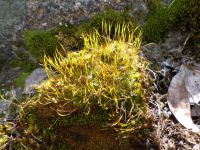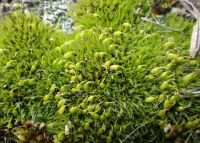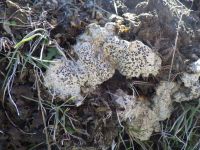Several different kinds of mosses can be commonly found in the Boise Foothills, growing on the ground or on boulders. Some of the most common are shown here, along with a couple of the more curious-looking lichens that also grow on the ground (vs. several more colorful species found on rocks and bark). Special thanks to Roger Rosentreter and Alma Hanson for identifications!
Mosses are in a fascinating group of plants called bryophytes. Lacking true roots or vascular tissue, our local mosses tend to have their most active growing period when there is abundant moisture and cool temperatures in winter and early spring (see “Plants That Love Winter“). Once days become hot, mosses become dormant by drying out completely, and can actually be killed if moistened and exposed to hot sun.
Mosses also have a bizarre (from our narrow point of view) life cycle. The leafy green component, called the gametophyte, has only a single set of chromosomes per cell, referred to as the haploid condition. Gametophytes are either male or female, producing either sperm or egg cells at the top of the leafy stems. Fertilized eggs grow into the stalklike component tipped with a spore-bearing capsule, called the sporophyte. Although attached to and dependent on the gametophyte, the sporophyte is actually a genetically distinct individual in which there are two sets of chromosomes, referred to as the diploid condition (the common condition in most animals and vascular plants). Haploid spores are produced in the sporophyte capsules and develop into new gametophytes, completing the cycle of alternation of generations.
Although often confused, or at least lumped together, lichens are a completely different critter, and are if anything even more bizarre than mosses (again, from our narrow point of view). Lichens are not even plants per se, but rather a more or less mutualistic combination of a fungus and an alga (the singular form of algae, which is technically plural), and sometimes one or more bacteria as well. Each unique kind of lichen is formed by a specific fungus that harbors specific unicellular algae, with the former providing soil nutrients and a protective environment for the algae, and the latter providing carbohydrates produced by photosynthesis.
The primary similarity between mosses and lichens is the relatively small size and tendency to become summer-dormant, allowing them to thrive on challenging sites like bare rocks and barren ground. In this capacity, their seeming insignificance belies a disproportionate ecological impact, by playing major roles in the biotic breakdown of rocks, nutrient cycling, and various other ecological services dependent on the biotic soil crust in semi-arid environments like the Boise Front.






